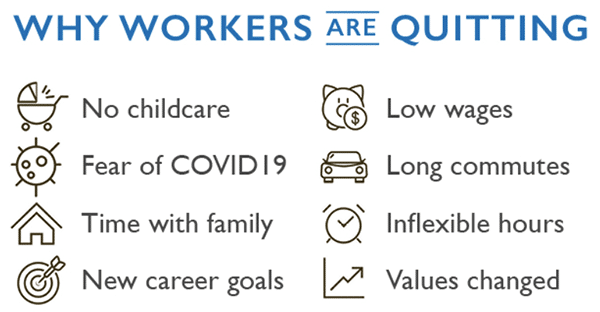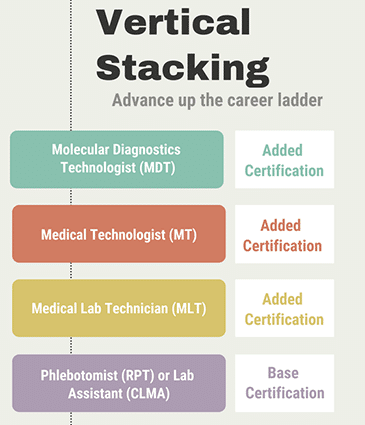
by Ashish Rangnekar of BenchPrep
The Great Resignation, the Great Reshuffle, the Great Reconsideration, the Big Quit. Whatever you call it, the underlying facts remain. A record-breaking 47.4 million people quit their job in 2021. In November alone, 4.5 million people quit—that’s an astonishing 3 percent of the total workforce in the U.S.

COVID has been a major driver, but to focus solely on the pandemic is to miss the bigger picture. And the opportunity. Among factors figuring into workers’ decision to resign are low wages and new career goals. Credentials can directly address both those factors. Credential holders often see increased earnings, and credentials can provide individuals entrée into new fields and professions.
Let’s look at three ways your learning business can use credentialing to respond to the current needs created by the Great Resignation.
- Unbundle the credentials.
- Partner with employers.
- Remove barriers.
Unbundle the Credentials
One relatively low-effort way to respond to current needs is to unbundle credentials you already offer. A year-long program can feel like an eternity. If you can provide something of value a learner can walk away with in a month or two, that’s a compelling offer. Unbundling is essentially a repackaging—and a reframing—of assets your learning business already has.
Depending on the area of focus, unbundling may or may not lead you to microcredentials. Whether the resulting credentials are micro or not, unbundling brings some clear advantages.
- Faster time to a credential
Smaller credentials allow individuals to attain something of value (the credential) more quickly—and in today’s fast-paced, fast-changing world speed is a true value-add. - Personalization
Unbundling allows individuals to personalize their credentialing path and focus on the knowledge and skills they need and want. Rather than forcing individuals to complete all the requirements of a larger, more time-intensive credential, individuals can pick and choose and customize their credentialing path to address gaps in their skills and knowledge or build new skills and knowledge in high-demand areas or areas that interest them.
Also, unbundling results in discrete credentials that can then be stacked to add value beyond that of the individual parts. There are two main approaches to stackable credentials.

- Vertical stacking
Vertical stacking thinks about credentials in a hierarchy and allows individuals to climb a career ladder. The vertical stack is like stairs, giving workers the steps they need to reach their career goals. Vertical stacking allows learners to go deeper in a domain. - Horizontal stacking
With horizontally stacked credentials, hierarchy is less important than subject matter. Learners expand their subject matter expertise by earning credentials in related areas. Horizontal stacking allows individuals to move along a career path by broadening their skills and knowledge.

American Medical Technologists offer credentials that can be stacked horizontally or vertically to unlock more value for the holders. A registered phlebotomy technician (RPT) or laboratory assistant (CMLA) may continue education to qualify for the medical laboratory technician (MLT) certification. An MLT can advance and take the medical technician (MT) exam with more education. That’s an example of vertically stacked credentials. As an example of horizontally stacked credentials, a registered medical assistant (RMA) may also qualify for a registered phlebotomy technician (RPT) certification and can earn an assessment-based certificate (ABC) in immunization or electrocardiography.
Unbundling allows those pursuing credentials to see their return on investment more quickly, and that ROI also redounds to employers and prospective employers who can fill talent gaps more quickly. And, of course, that means faster ROI for the learning business offering the credentials.
Partner with Employers
A big part of what makes a credential meaningful is how employers value it. Broadly speaking, employers value credentials that verify the holder truly possesses the knowledge and skills associated with the credential. To know what knowledge and skills employers need, you need to do the work to align your credentials with employer needs and the job market.
There are two main paths to doing that:
- Get employers to spend on your credential for their employees.
- Develop a credential in partnership with one or more employers.
Large companies like AT&T, Amazon, and Deloitte are spending hundreds of millions of dollars to retrain, reskill, and upskill their workforce. And they are not training companies. They rely on industry-recognized certifications and other credentials to train their massive employee bases.
For example, if an Amazon employee wants to pursue a career in supply chain management, Amazon may recommend a supply chain certification from the Association for Supply Chain Management (ASCM). If an AT&T technician wants to pursue a career in networking, they may recommend a CompTIA Network+ certification.
Your learning business’s credentials and programs should be top of mind for employers that encourage their employees to get the right skills and knowledge—and that may be willing to underwrite some or all of the costs.
The other approach is to work with an employer or employers to build a credential that directly addresses their needs.
For example, PwC is in the process of upskilling all 50,000 of its U.S. employees through its Digital Academy program. But how will PwC know if someone has truly mastered those digital skills? To determine this, they might need a certification that can help prove competency. A learning business could provide significant value to PwC by serving as an independent third party to create that certification, giving it real rigor and validity.
Remove Barriers
Put yourself in the shoes of your audience. What barriers do they face when trying to pursue or achieve credentials? What can you do to remove or lower those barriers?
The unbundling approach already touched on is one way to address the barrier of time-to-credential and likely also the barrier of cost.
Another major barrier for many would-be-credential-holders is preparing for the credential. Many adult learners don’t know how to study or prepare for exams effectively. By providing prep and practice, you can lower dropout rates and facilitate successful completion.
The Graduate Management Admission Council (GMAC) is a great example. They launched a new exam alongside offering a practice solution so candidates could get used to the exam experience and be better prepared to pass the test. The result is that 96 percent of the candidates who used the practice solution said they felt better prepared for the exam.
Technology can help your learning business provide prep and practice at scale and in a personalized way that supports individual learners on their unique learning and credentialing journey.
The recent surge in resignations represents an opportunity for learning businesses attuned to the market. More individuals are hungry for effective, efficient ways to gain and demonstrate skills and knowledge as they look for their next position, and employers need ways to attract and retain talent. The certifications, certificates, and other credentials offered by learning businesses can address the needs of both learners and employers.
By unbundling the credentials, working with employers, and addressing the barriers your learners face, you can make the certifications, certificates, and other credentials offered by your learning business even more valuable and appropriate for the current moment.
About the Author
Ashish Rangnekar is the co-founder and CEO of BenchPrep, a Chicago-based enterprise SaaS digital learning company purpose-built to help your candidates feel more confident and prepared for the test. Under Ashish’s leadership, BenchPrep has built a world-class team of 100+ employees and has helped some of the world’s leading education and training companies digitally transform their product offerings. Customers include CFA Institute, ACT, McGraw Hill Education, National Conference of Bar Examiners, Association of American Medical Colleges, and more.
See also:


 Measured Risk-Taking with Clare Marsch of ABA
Measured Risk-Taking with Clare Marsch of ABA
Leave a Reply